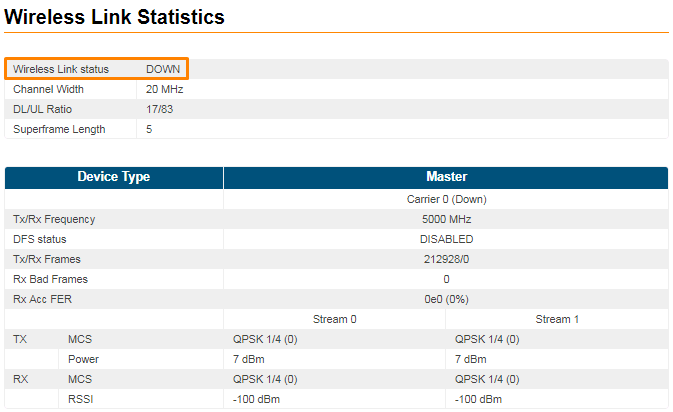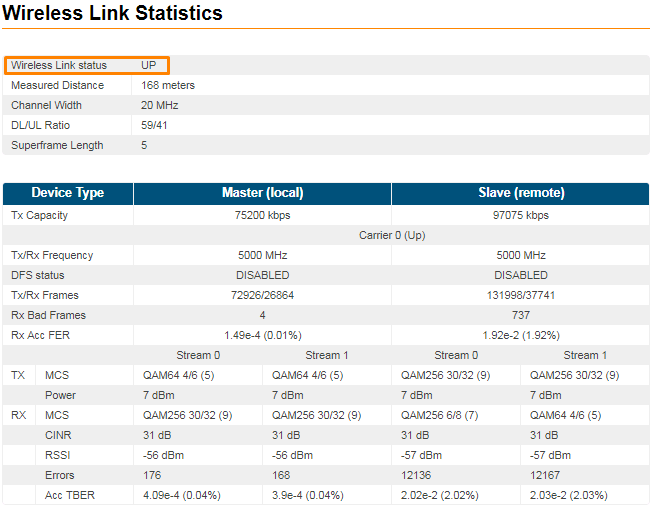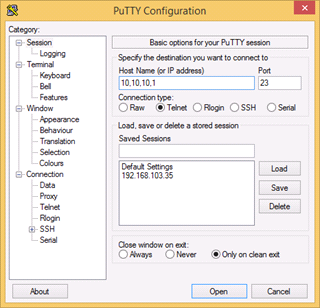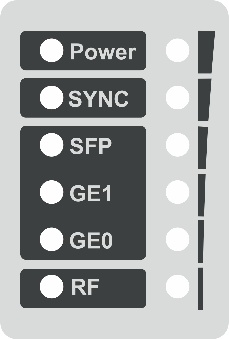commissioning| Metadata (Metadata Plugin) |
|---|
|
Commissioning |
...
- Use InfiNet Wireless link planner tool InfiPLANNER to estimate link performance and required configuration in terms of antennas, channel width, Tx power, etc.
- Determine line of sight conditions and obstacles along the path
- Perform spectrum analysis and figure out spectrum occupation and available channels
The equipment list required for lab configuration
...
Units settings can be performed via:
Settings via web interface
| Anchor |
|---|
| Settings via web interface |
|---|
| Settings via web interface |
|---|
|
| Step 1 |
|---|
Access the unit to the default IP address 10.10.10.1 with mask 255.255.255.0 via web browser. Make sure that the Ethernet port of the Laptop has an IP address assigned from the same network class as the one for the unit (for example, set 10.10.10.50 with mask 255.255.255.0). |
| Step 2 |
|---|
Use any letters or numbers for initial authentication, for example: - User name: "login".
- Password: "password".
| Note |
|---|
| After the initial login to the units, it is recommended to change the user and password to more secure permanent values. |
|
| Step 3 |
|---|
Enter to the unit. Initially the status of the radio link is DOWN like below. | Center |
|---|
| Scroll Title |
|---|
| title | Figure - Initial link status |
|---|
|  |
|
|
| Step 4 |
|---|
Upgrade the units to the newest available firmware.
|
| Step 5 |
|---|
Perform radio settings. Go to the "Radio" section and set the following parameters: - Node Type (one unit must be set to Master and the other one to Slave).
- Link ID.
- Channel Width.
- Frame period.
- Max Distance.
- Center Frequency.
- Maximal Transmit Power.
| Note |
|---|
| Make sure that both units are configured with maximum Tx power. |
| Note |
|---|
| The detailed description for each radio setting can be found in the section "Radio". |
| Warning |
|---|
| Please note that the following parameters must have the same values at each of the two units in the PtP link. Otherwise the wireless link between them won’t be established: - Center Frequency
- Channel Width
- Frame Period
- Max Distance
- Short Cyclic Prefix
- Link ID
|
|
| Step 6 |
|---|
Save the configuration, reboot both units and check if they link up after reboot. The link status should be UP and the radio statistics should indicate the capabilities and quality of the link. | Center |
|---|
| Scroll Title |
|---|
| title | Figure - Link UP status |
|---|
| 
|
|
|
Settings via CLI
| Anchor |
|---|
| Settings via CLI |
|---|
| Settings via CLI |
|---|
|
| Step 1 |
|---|
CLI is available via telnet: "cmd> telnet 10.10.10.1" or use any suitable telnet client such as Putty. | Center |
|---|

|
|
| Step 2 |
|---|
Use any letters or numbers for initial authentication, for example: - User name: "login".
- Password: "password".
| Note |
|---|
| After the initial login to the units, it is recommended to change the user and password to more secure permanent values. |
|
| Step 3 |
|---|
Chech the firmware version and upgrade the units to the newest available firmware. You can check firmware version via command: | Code Block |
|---|
| language | powershell |
|---|
| theme | Emacs |
|---|
| xginfo version |
Compare current version of the unit with version on official InfiNet ftp server: ftp://ftp.infinet.ru/pub/Firmware/XG/H12. In case of newer version is available it is recommended to upgrade the firmware.
|
| Step 4 |
|---|
Configure radio parameters. | Center |
|---|
| Parameter | Command | Value (example) |
|---|
| Node Type | xg -type | master (slave) | | Link ID | xg -cell-id | 1 | | Channel Width | xg -channel-width | 40 | | Frame period | xg -sframelen | 5 | | Max Distance | xg -max-distance | 1 | Downlink Center Frequency
| xg -freq-dl | 4960 | Uplink Center Frequency
| xg -freq-ul | 5010 | Maximal Transmit Power
| xg -txpwr | 10 |
|
| Note |
|---|
| Make sure that both units are configured with maximum Tx power. |
| Warning |
|---|
| Please note that the following parameters must have the same values at each of the two units in the PtP link. Otherwise the wireless link between them won’t be established: - Center Frequency
- Channel Width
- Frame Period
- Max Distance
- Short Cyclic Prefix
- Link ID
|
| Note |
|---|
| In order to synchronize the units settings, copy from one unit and paste to another the "Peer exported config" line shown in the "xg config -peer-exported" command output. See the configuration example below: | Code Block |
|---|
| #Peer exported config:
xg -v3-start
xg -v3 a01b833402f59907abdcb812d5de20fd.Ko7ClHTRVps/8oyNjnucBcSqUlcCJbOae9Kf4OZ
xg -v3 zRU7tYm1REMTUyHWYTaGGuuooDp2DWkcxyFGLmEb5yx45wFImL5Nx72XK6bnl9AzRdZjWVSN
xg -v3 xCrliSUfn7JZazn1yTEKE90fKLIK/HKNJXYN7vg4lEocgBWguYdFc/u8fEwENtJYBSKNGbu3
xg -v3 HQ0HvIdTqAwOz5vXM89CkhL5ZZmDuYN3FFSo6wV+h//zBuSfuJ5QVb6fv2Do6tPIE4kuZSsB
xg -v3 UXLavUriPtSlRxzIYUO7+9XSMggomrf7NZtM37PxQkUYIZ116K3++w5HPVXXq8Po7xVmotnq
xg -v3 px1uDbYtSjs2O9yx6h6Z0HGp8GLAEY7Ka5ZRoyAvyfA73pobYrEhzZ+hdwWnDDJYM3DmAhuW
xg -v3 yAUgtVHJ4hC9u6BP5IAlQXsm5QSbuRwihWdmrwiThwSGmXiZWCXOmxzg1IA==
xg -v3-end |
|
|
| Step 5 |
|---|
Save configuration. | Code Block |
|---|
| language | powershell |
|---|
| theme | Emacs |
|---|
| config save |
|
| Step 6 |
|---|
Restart the unit. | Code Block |
|---|
| language | powershell |
|---|
| theme | Emacs |
|---|
| restart yes |
|
| Step 7 |
|---|
Check the link establishment. | Code Block |
|---|
| language | powershell |
|---|
| theme | Emacs |
|---|
| Sys log show | grep UP |
In case of success configuration: | Code Block |
|---|
| language | powershell |
|---|
| theme | Emacs |
|---|
| [XG]: changed state UP->DOWN |
|
| Step 1 |
|---|
Install both units on the pole and direct them at each other (more detailed information about units installation and antenna alignment is described in the section "Units Installing"). |
| Step 2 |
|---|
Turn them on and make sure that the units subsystems are working properly. This can be done by LED indication. | Center |
|---|

|
| Center |
|---|
| Scroll Title |
|---|
| title | Table - Indicator Panel Description |
|---|
| | LED | Normal state | Function |
|---|
| Power | On | On - power is applied to the device Off - no power is applied or improper power source | | SYNC | On | TDD-synchronization | | SFP | On | Ethernet link | | GE1 | On | Ethernet link | | GE0 | On | Ethernet link | | RF | On | RF link. Blinking while establishing RF link |
|
|
|
| Step 3 |
|---|
Perform coarse alignment using built-in signal strength indicators. | Note |
|---|
| The more indicators are on, the better wireless connection is established. The blinking indicator means an intermediate state. The more often the indicator blinks the higher level connection is established. |
|
| Step 4 |
|---|
Perform fine alignment using the "Alignment tool" available in the Web interface or "xginfo stat" output in the CLI. Try to maximize CINR and RSSI readings. Please follow the detailed indications from section Antenna alignment for a proper antenna alignment. |
| Method 1 |
|---|
Depending on the values for CINR, RSSI change the following parameters: - Decrease/increase the Tx power level in order to have the CINR above 28 dB and the RSSI between -40…-60 dBm.
- Enable ATPC mode with setting "Target RSSI" value. The RSSI value of the master tries to engage the target range, the center value of which is the "Target RSSI".
|
| Method 2 |
|---|
Use the Spectrum Analyzer tool built-in the Web GUI in order to determine the best frequency and to check the radiation levels in the installation area. Frequency should be left to "auto" in case of Instant DFS units (for unlicensed bands), or it should be set to a specific value (in countries where DFS is not mandatory) on the master unit after performing the Spectrum Analyzing test on both units. |
| Method 3 |
|---|
Select the most appropriate air frame period: - A shorter frame period gives lower latency, but also has higher overheads.
- Using longer frame periods cuts down overheads, but increases the latency.
|
| Method 4 |
|---|
| Enable "Short Cyclic Prefix" mode in order to mitigate inter-symbol interference due to multipath propagation environment. |
| Method 5 |
|---|
| Enable "Control Block Boost" mode that improves link availability in the most difficult propagation and interference conditions due to the radio frame with control information transfer at duplicate transmit power. |
| Method 6 |
|---|
| Enable "Instant DFS" that gives availability to change frequency without link interruption. |
| Method 7 |
|---|
Monitor air block error rate by checking the "Acc TBER" parameter in the "Status" page or in "xginfo stat" output and adjust the AMC strategy if necessary. | Note |
|---|
| Acceptable error rate depends on the application. See some examples in the table below. |
| Center |
|---|
| Scroll Title |
|---|
| title | Table - Acceptable error rates for different applications |
|---|
| | Application | Acceptable error rate |
|---|
| TCP-based applications (web, FTP, etc.) | 10-4 | | Voice-over-IP | 10-5 | | UDP video (CCTV, IPTV, etc) | 10-6 | | TDM-over-IP | 10-7...10-9 |
|
|
The "AMC Stratefy" may be changed depending on customer erquirements: - “conservative” assumes using higher CINR thresholds in order to minimize the error rate.
- “aggressive” lowers the thresholds in order to use higher modulation levels and thus increase the throughput.
- “normal” represents a balance between the error rate and throughput values.
It is recommended to use “normal” strategy initially and adjust it based on target and actual TBER values. |


